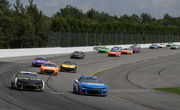
via Getty
AVONDALE, AZ – NOVEMBER 07: #9: Chase Elliott, Hendrick Motorsports, Chevrolet Camaro NAPA Auto Parts races #5: Kyle Larson, Hendrick Motorsports, Chevrolet Camaro HendrickCars.com during the NASCAR Cup Series championship race on November 7, 2021 at Phoenix Raceway in Avondale, Arizona. (Photo by Kevin Abele/Icon Sportswire via Getty Images)

via Getty
AVONDALE, AZ – NOVEMBER 07: #9: Chase Elliott, Hendrick Motorsports, Chevrolet Camaro NAPA Auto Parts races #5: Kyle Larson, Hendrick Motorsports, Chevrolet Camaro HendrickCars.com during the NASCAR Cup Series championship race on November 7, 2021 at Phoenix Raceway in Avondale, Arizona. (Photo by Kevin Abele/Icon Sportswire via Getty Images)
With the introduction of the Gen-7 car in 2022, NASCAR has brought a different look to the sport. While the motive was to make it a level-playing ground for all involved, it certainly has divided opinions. Having said that, the impact of the Next Gen cars is definitely seen in the Cup Series. However, the burning question right now is, have these cars helped the sport get better?
Unveiling NASCAR’s Next Gen Cup Car: Importance and Purpose Explored
Had it not been for the Covid-19 global pandemic, we would have seen the Next Gen car come into place in 2021 itself. However, it was finally rolled out in 2022 and since then, a lot has happened. The primary reason for NASCAR to push this idea was pretty clear.
ADVERTISEMENT
Article continues below this ad
With the Next-Gen car, the main motive was to lower the costs involved and, at the same time, attract other OEMs to enter the competition. Another perspective behind this idea was to make the racing better with the aerodynamics involved and also to widen the relevance of the sport.
Certainly, it is no child’s play to sustain in NASCAR with all the costs involved. One of the best examples is that of Furniture Row Racing. It was just in 2017 that they were champions with Martin Truex Jr. And just a year later, they were forced to shut down its doors.

via Getty
DAYTONA, FL – JANUARY 12: Dale Earnhardt, Jr., driver of the #5 Hendrick Motorsports Hendrickcars.com Chevrolet, during Next Gen Testing on January 12, 2022 at Daytona International Speedway in Daytona Beach, Fl. (Photo by David Rosenblum/Icon Sportswire via Getty Images)
While there is no assurance of sponsorship revenues with plenty exiting over the years, NASCAR needed to cut down the costs involved. Furthermore, the sport needed to have a level-playing field in every aspect. This would involve teams not making parts anymore and buying them from a single-source supplier. With this in place, it would come down to talent and strategies on the track.
Interestingly, despite the cost cutdown, NASCAR’s new car has some significant and attractive changes on the outside.
Trending
Next-Gen car’s visual aesthetics
The Next-Gen car has a sleeker and a more coupe look as compared to the previous generations of cars in NASCAR. It features a shorter greenhouse [the “glassed” area above the fender line], shortened deck lid, and a widened track width. In addition, it possesses 18″ forged aluminum wheels and wider tires. As opposed to the five-lug-nut design earlier, the new car features a single-lug-nut design.
With modern technology in place, the new car sees an upgrade in independent rear suspension, rack and pinion steering, and larger brakes. To enable electrification in the car in the future, they have combined the transmission and rear gear into a single package.
The availability of an in-car camera brings a different perspective to a fan’s point of view. Most interestingly, the redesigning of the chassis sees new front and rear bumpers, enhancing the safety of the car. What’s more impressive is how the front and rear clips of the car are bolted into the center section. This will help immensely in serviceability and damage repair, reducing downtime drastically.
Also, plenty of the car components aim to bring down the aerodynamic forces and the impact of “dirty air”. Furthermore, an underwing and rear diffuser seals the bottom of the car. Interestingly, the louvers in the hood allow to maximize the engine performance regardless of the aerodynamics. In fact, this is the very component Hendrick Motorsports were guilty of modifying at Phoenix Raceway in the 2023 season.
While plenty of debates took place, NASCAR went ahead with a package involving high horsepower and low-downforce aerodynamics. The new stock car has an engine output of 670 horsepower at the majority of the racetracks, with a four-inch spoiler on the rear deck lid. However, as far as Superspeedway racing is concerned, an engine output of 510 horsepower and a seven-inch spoiler will come into play.
Major Changes Introduced in the Next-Gen Car
Unsurprisingly, NASCAR has gone ahead with a number of changes in the Gen-7 car to make it better than the previous versions. One of the major changes involves the usage of common parts manufactured by more than 30 single-source suppliers. Earlier, teams used to build the tube-frame chassis and plenty of internal components themselves.
Prioritizing the safety of the car, the driver’s seating has been moved 1.6 inches further toward the center of the car. In addition, the door bars have been moved further outwards to protect the drivers from side impact. One of the biggest changes would be the customized aerodynamics adaptable to each type of track. Another notable difference features having a diffuser under the rear of the car.
As the Next Gen car now offers independent suspension in the rear, changes are made in a similar manner in the rear of the car as well.
Shims are also used to adjust other setup measurements such as toe, which is the angle of the tire relative to the centerline of the car. pic.twitter.com/SJEnzFvgo0
— NASCAR (@NASCAR) March 24, 2022
The Next-Gen car also sees replacing the four-speed manual gearbox with a six-speed [five forwards, plus reverse] sequential shift transmission manufactured by Xtrac. It also possesses a new transaxle that combines the transmission and rear gears into one package. Interestingly, the redesigned chassis includes new front and rear bumpers with the front and rear clips bolted to the center section of the vehicle.
One of the other major changes includes replacing the 15-inch wheels featuring five lug nuts with 18-inch BBS-supplied wheel rims featuring a single, center-locking nut. In fact, for the very first time, the new cars will be symmetrical. Although the traditional 5.86-liter V8 engines are retained, it allows a provision to accept a powertrain with a hybrid system in the near future.
While it is unlikely that a new OEM enters NASCAR until the engine is replaced, the governing body plans to introduce a hybrid system. This will encourage electrification in a certain way and hopefully motivate others to enter the sport.
Is the NASCAR Next Gen car safe?
Regardless of anything, the safety of the drivers will be always the priority for NASCAR. With the Next-Gen car, plenty of tests have been conducted, which also saw NASCAR work with the University of Nebraska for crash testing. Around 7,000 to 8,000 simulations where the new car was crashed into the wall to ensure its desired functionality.
In fact, two fully built cars were taken to Talladega Superspeedway. Using a robot, the cars were crashed into the wall at 130 miles per hour. Fortunately, the real-world crash testing validated the desired results as it was achieved through simulation.
The impressive thing about NASCAR is that it has always acted on real-time data and incidents to improve safety. For the Next-Gen car, they have used data from the past 20 years in designing the car. Thereby, they have incorporated all those learnings to assure the safest possible setup for racing.
Crash test footage of the rear end updates to the NASCAR Next Gen car from the latest episode of Race For The Championship on USA.
Left side is current design which crumples but is visibly stiffer while the updated version on the right crumples much more due to removed bars. pic.twitter.com/nziGfJ74By
— Bozi Tatarevic (@BoziTatarevic) October 28, 2022
That being said, NASCAR felt the need to improvise after two play-off eligible drivers suffered from concussions in the Gen-7 cars in 2022. Kurt Busch and Alex Bowman were the victims in this case. Citing this and other frequently occurring issues, NASCAR brought some changes in safety regulations prior to the beginning of the 2023 season.
The improved design sees the removal of some bars, reduction in thickness of some tubing along with adding pivot points called triggers, which encourages deformation. In addition to that, they mandated new incident data collection systems for all Cup Series cars from the 2023 season. Hopefully, this should help with reverse engineering and enhance the safety of the drivers.
ADVERTISEMENT
Article continues below this ad
Car numbers on the Next Gen vehicle
Another significant change that comes with the Next Gen car is the placement of car numbers. Initially, the number was placed centrally but now demands a change as the car features a small quarter panel. It is now forward and placed just behind the front wheels.
This will avoid taking up most of the door space. Not only that, but it will also allow more space for sponsors and their logos. The change comes after the number was experimentally placed just in front of the rear wheels for the 2020 All-Star race.
ADVERTISEMENT
Article continues below this ad
WATCH THIS STORY: NASCAR Fans Defend Chase Elliott’s Replacement Amid Unreasonable Expectation for Drivers Making Their First Next Gen Cup Appearance
While all these should attract sponsors, it is interesting to see the cars’ performance. Hopefully, over time, it helps in providing some competitive and healthy racing.
ADVERTISEMENT
ADVERTISEMENT
ADVERTISEMENT
ADVERTISEMENT






